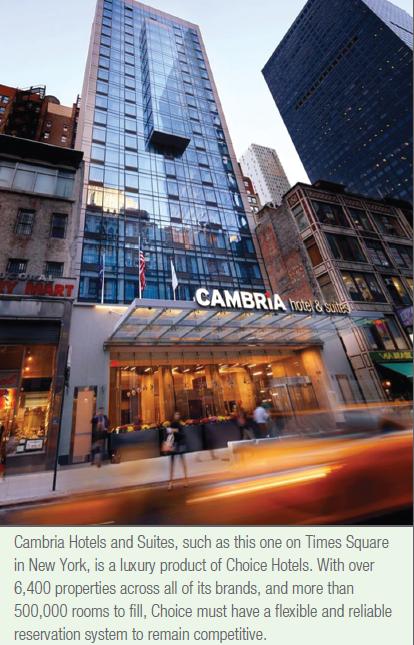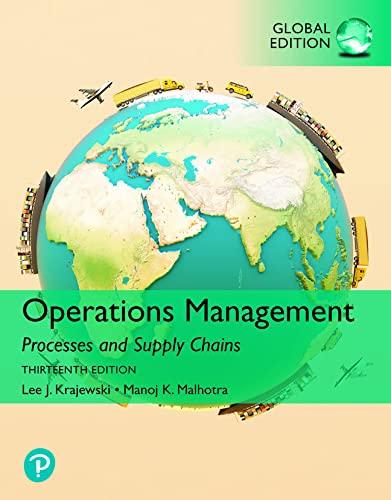Choice Hotels International is the company behind well-known hotel brands that range from budget-friendly EconoLodge and Rodeway
Question:
Choice Hotels International is the company behind well-known hotel brands that range from budget-friendly EconoLodge and Rodeway Inns to Quality, Comfort Inns and its luxury brands, Ascend and Cambria. Over 6,400 properties are part of the franchisor's offerings both domestically and abroad. This translates to over 500,000 rooms around the globe.
To help hotel guests find and book those rooms, Choice Hotels maintains a robust central reservation system, or CRS, that must connect travel agents, online reservation websites such as Trivago and Kayak, and mobile app users to the company's daily available inventory. On the back end, the system also must connect to each property's front check-in desk system and the organization's revenue management systems. For Choice, the CRS is the heart of hotel operations and the company could not operate without it.
The company first developed its CRS back in the 1980s using the latest project management techniques and information technology (IT) available. But the company's growth, coupled with dramatic changes in information technology and the cost of maintaining inflexible systems built for last century business that couldn't scale with growth, compelled the organization in 2014 to embark on a multimillion dollar, multiyear project, called choiceEDGE, to replace this mission-critical system by 2017. To replace such a vital system, Todd Davis, Choice's chief information officer (CIO), knew the company couldn't just remove the old software and hardware systems and then plug in brand-new ones. The risk was too high. Nor could Choice Hotels rely on a linear systems development approach that would require the company to deliver a finished solution that would be outdated at the end of several years of work.
The world of business and technology were changing too rapidly to wait. The company has seen hospitality industry competitors spend hundreds of millions doing just that, with failed outcomes. Instead, senior management at Choice Hotels committed to a new IT project management approach, called "Agile," that allowed development to occur iteratively around "projects within projects" so as each requirement outlined in its work breakdown structure (WBS) was completed, it could be deployed without disruption to the entire enterprise. This approach both minimized the risk of business disruption and allowed new features to be seamlessly rolled out without the need for major workforce training initiatives. It also allowed franchisees to start seeing the benefit of the new "heart" just months after helping to define the desired business outcomes, instead of waiting years. To get started, Choice defined its project scope and objectives with input from its various stakeholders: thousands of franchisees, dozens of external business partners, millions of customers, and thousands of employees.
Brian Kirkland, vice president of engineering, was chosen to head up the project team of nearly 120 systems architects, "scrum masters" (daily project managers), software developers, and quality assurance professionals at Choice's Scottsdale, Arizona, location. From the start, Kirkland wanted the team to use all the tools available to manage the project. For example, early on in the project, Denise Tower, director of IT project management and delivery, used WBS and Gantt charts to identify the critical path. Kirkland and his team quickly realized that the system's underlying distribution engine (the platform upon which all the functionality rested) was in the critical path.
Any problems or delays would cause downstream delays and cost the company software programmer idle time. So resources were shifted to getting this core system functionality in place and off the critical path. Resources were then redirected back toward completion of the business outcomes that relied on the distribution engine, which were delivered weekly throughout the project's entire development process. Daily monitoring meetings, called "daily stand-ups," were held each morning to keep the focus on the work at hand, and ensured that issues got priority attention for resolution to avoid those parts of the project ending up in the critical path and causing downstream delays.
Today, choice EDGE is capable of quickly scaling to meet the business demands it faces in the competitive hospitality industry. The system processes over 250 million transactions a day that include simple shopping queries for room rates and availability, pricing and inventory updates, or actual room bookings. Amazon Web Services is used for cloud storage. And as the demand for mobile access to its systems continues to grow, the company's IT department is equipped to rapidly respond.
QUESTIONS
1. Assess the four categories of a risk-management plan for the choice EDGE project. Given the information in the case, how risky is this project for Choice Hotels?
2. Go online to research "Agile" information systems development and the role of "scrum masters" in helping organizations manage successful IT projects. Why are leading organizations now turning to this approach for developing their systems projects?
3. Assume you are Denise Tower and have responsibility for the overall management of the choiceEDGE IT project. Describe what you might need to do to monitor and control the project to ensure scope, budget, and schedule are managed.
Step by Step Answer:

Operations Management Processes And Supply Chains
ISBN: 9781292409863
13th Global Edition
Authors: Lee Krajewski, Naresh Malhotra, Larry Ritzman





